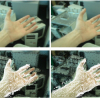Free Online Productivity Tools
i2Speak
i2Symbol
i2OCR
iTex2Img
iWeb2Print
iWeb2Shot
i2Type
iPdf2Split
iPdf2Merge
i2Bopomofo
i2Arabic
i2Style
i2Image
i2PDF
iLatex2Rtf
Sci2ools
100
click to vote
ICCV
2009
IEEE
2009
IEEE
Background Subtraction for Freely Moving Cameras
Background subtraction algorithms define the background
as parts of a scene that are at rest. Traditionally,
these algorithms assume a stationary camera, and identify
moving objects by detecting areas in a video that change
over time. In this paper, we extend the concept of ‘subtracting’
areas at rest to apply to video captured from a freely
moving camera. We do not assume that the background is
well-approximated by a plane or that the camera center remains
stationary during motion. The method operates entirely
using 2D image measurements without requiring an
explicit 3D reconstruction of the scene. A sparse model of
background is built by robustly estimating a compact trajectory
basis from trajectories of salient features across the
video, and the background is ‘subtracted’ by removing trajectories
that lie within the space spanned by the basis.
Foreground and background appearance models are then
built, and an optimal pixel-wise foreground/background labeling
...
Related Content
| Added | 13 Jul 2009 |
| Updated | 10 Jan 2010 |
| Type | Conference |
| Year | 2009 |
| Where | ICCV |
| Authors | Yaser Sheikh, Omar Javed, Takeo Kanade |
Comments (0)

